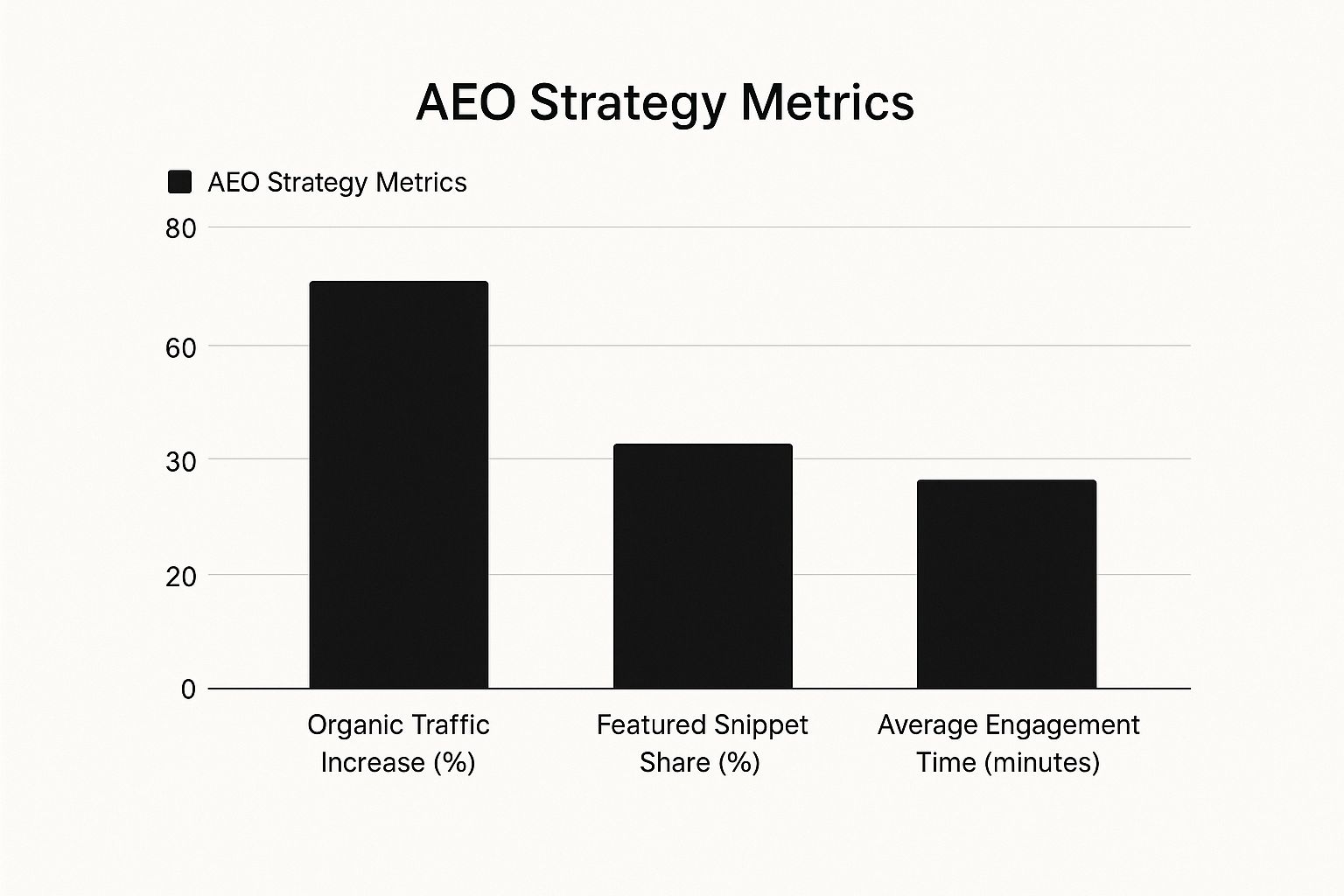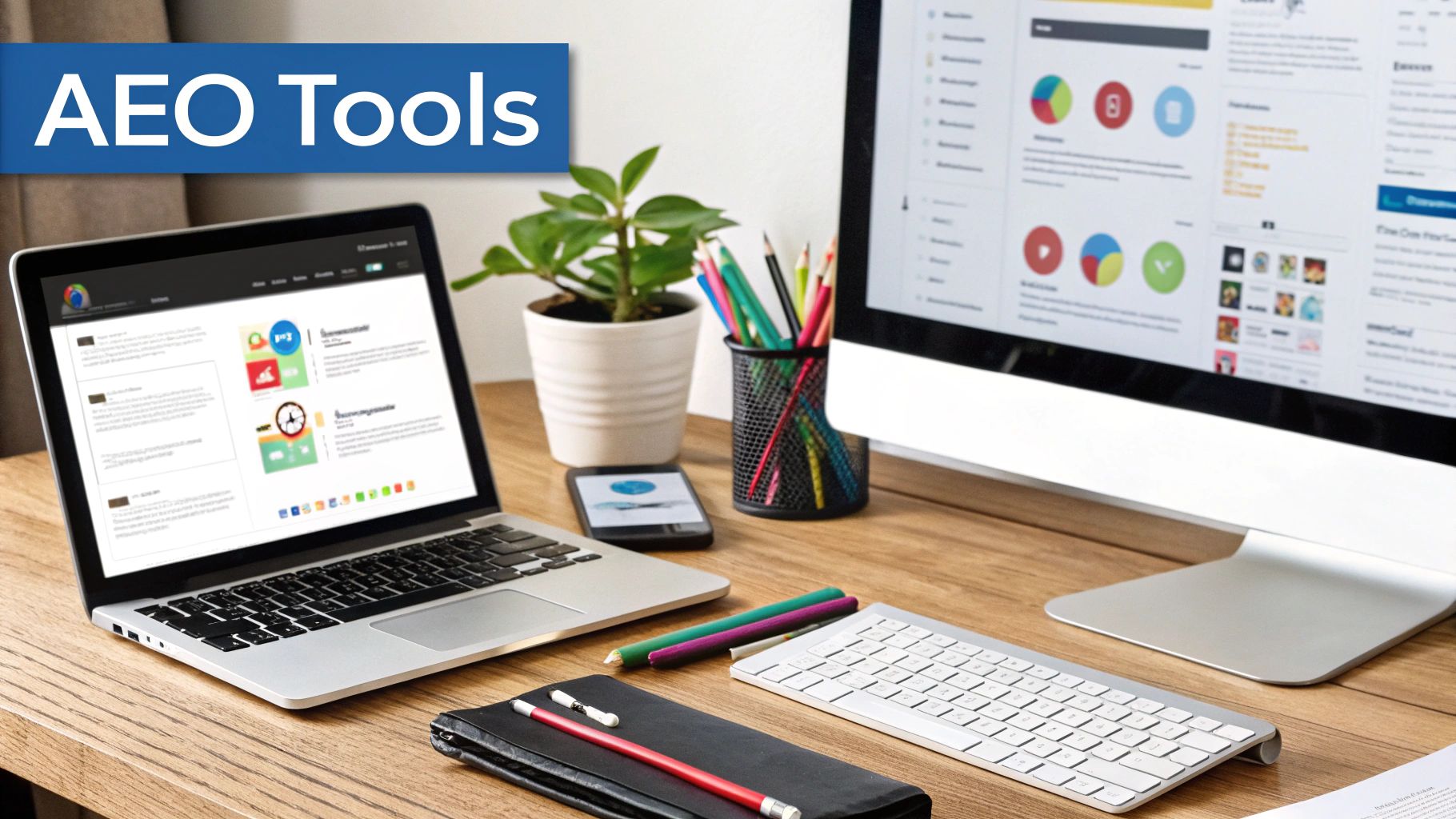Answer Engine Optimization: Boost Your Content Strategy
What Answer Engine Optimization Really Means for Your Content

Imagine asking a librarian a question and, instead of pointing you to a shelf full of books, they hand you a perfectly crafted answer drawn from multiple sources. That's the power of answer engines. Think ChatGPT, Google's AI Overviews, or Bing Chat. They're changing how we access information, giving us direct answers instead of just a list of links.
This shift from search results to direct answers has a big impact on how we find and use information online. Answer engine optimization (AEO) isn't just another SEO fad. It's a fundamental change in how we create content that AI systems will cite.
Understanding the Shift to Direct Answers
Traditional SEO is all about getting your website to the top of the search results. AEO, on the other hand, is about getting your content inside the answer itself. You're optimizing for AI, not just search algorithms.
This subtle but significant difference demands a new approach to content. It means focusing on content that is clear, concise, and authoritative. Think of it this way: instead of targeting a broad keyword like "best running shoes," you're answering specific questions like "What are the best running shoes for marathon training on concrete?"
Why Answer Engine Optimization Matters Now
The rise of generative AI and answer engines has significantly changed the search and content optimization landscape. Answer engine platforms like ChatGPT already account for about 1% of the global search market. Conversational AI tools are attracting millions of users every month.
This shows a real change in user behavior. It underlines the growing importance of AEO. Being the source that answer engines rely on means providing accurate information that's easy to access. You can learn more about AEO's growth and influence in 2025 here.
How Content Creators Are Adapting
Savvy content creators are adapting to this new reality by prioritizing helpfulness and authority. Traditional ranking factors are still important, but they aren't the only focus. Here's what they're concentrating on:
- Creating comprehensive, in-depth content: Detailed answers build trust and establish your content as a reliable source.
- Structuring content logically: Using clear headings, bullet points, and tables makes information easy for both people and AI to process.
- Using structured data: Adding schema markup helps answer engines understand the context and relevance of your content.
This shift in focus makes sure that content is not just discoverable, but also chosen as the definitive answer by AI. It's how creators become recognized experts in their fields, setting themselves up for success in the evolving world of AEO.
Why Featured Snippets Are Your Gateway to Answer Engine Success
Featured snippets are like getting VIP access to the answer engine world. Snagging that position zero spot doesn't just put you front and center; it tells answer engines that your content is the gold standard. While some worry that zero-click searches might hurt website traffic, they actually build brand credibility in a way traditional clicks can't match.
Featured Snippets: More Than Just Clicks
Featured snippets are highly engaging because they give users exactly what they're looking for – quick, direct answers. Think of them as a stepping stone to broader visibility within answer engines. Smart content creators use position zero to build trust and authority, something answer engines consistently reward. This lays the groundwork for successful answer engine optimization (AEO).

The infographic above shows how a solid AEO strategy impacts three key metrics: organic traffic increase, featured snippet share, and average engagement time. Notice the correlation: a higher percentage of featured snippets goes hand-in-hand with more organic traffic and longer engagement times. This demonstrates the power of position zero in creating meaningful user interactions.
To better understand the nuances between traditional search and the emerging power of answer engines, let's take a look at a comparison table. This table highlights the core differences in how each approach handles user queries and delivers results, and what that means for your content strategy.
| Aspect | Traditional Search | Answer Engines | Impact on Content Strategy |
|---|---|---|---|
| Goal | Provide a list of relevant links | Deliver a concise, direct answer | Shift focus from driving clicks to providing comprehensive, authoritative information |
| User Interaction | User clicks on a link to find information | User receives an answer directly on the search results page | Prioritize clear, concise answers to common user queries |
| Content Format | Optimized for keywords and backlinks | Structured for easy extraction and summarization by AI | Adopt a question-and-answer format, using headings and subheadings to guide AI understanding |
| Metrics | Click-through rate (CTR), organic traffic | Featured snippet share, brand mentions, citations | Track metrics related to answer engine visibility and brand authority |
| Focus | Ranking high on the search results page | Securing position zero and being cited by AI | Optimize content for both traditional search and answer engine inclusion |
As you can see, adapting to answer engines requires a shift in thinking. It's less about simply ranking high and more about becoming a trusted source that AI can rely on.
Optimizing for Featured Snippets and AEO
Featured snippets and zero-click searches, both tightly linked to AEO, are now central to the search experience. In 2025, featured snippets boasted the highest click-through rate (CTR) at a whopping 42.9%. Interestingly, 52% of sources cited in Google's AI Overviews already rank in the top 10 organic results. For more SEO statistics, check out AIO SEO. Specific content structures and optimization techniques can make your content attractive for both featured snippets and AI-powered responses.
Building Trust and Authority Through Position Zero
Getting featured snippets isn't just about answering a question; it's about showing off your expertise. When your content consistently lands in position zero, it signals to answer engines that you're a reliable source. This, in turn, makes it more likely that your content will be cited in AI-generated responses, expanding your reach and influence. If you're interested in diving deeper into generative search optimization, you can learn more here.
By grasping the connection between featured snippets and broader AEO success, you can create content that not only ranks well but also establishes your brand as a trusted authority in your field. This sets you up for long-term success in the ever-changing search landscape.
The Secret Language Answer Engines Speak: Structured Data Mastery
Imagine you're trying to explain something complex, like baking a cake, to a friend. You'd naturally use language a human understands, right? But what if you were explaining it to a computer? That's where structured data comes in – it's like a universal translator for answer engines. It helps them understand the context and meaning behind your content.
This isn't about stuffing your website with technical jargon. Instead, think of structured data as organizing your information so the answer engine can easily digest it. This builds the AI's confidence in your authority on the subject.
It's vital for answer engine optimization (AEO). A human can follow a recipe even if it's a little disorganized. An answer engine, however, needs clear signals for ingredients, timing, and temperature to understand the process fully.

This screenshot from Schema.org illustrates the concept perfectly. Schema.org is a collaborative project that creates and maintains structured data schemas. These schemas help search and answer engines understand the content on your website. It's a treasure trove of information for developers and SEO professionals.
Schema Types That Matter
Some schema types are especially helpful for AEO. For instance, FAQ schema directly feeds into AI responses. Similarly, How-to structured data can get your step-by-step processes featured in answers. Think of them as giving the answer engine the precise information it craves.
This structured approach isn't just a technical checkbox – it helps answer engines trust and interpret your content. Research shows that structured content performs significantly better. Studies from 2025 show that sites using comprehensive schema, especially for FAQs, How-tos, and products, saw a major boost in knowledge panel and direct answer features. Structured content is up to 4x more likely to be featured by answer engines. Learn more about AEO and structured data here.
Practical Application of Structured Data
Structured data isn't just a technicality – it dramatically improves how answer engines display your content to users seeking trustworthy information. Imagine your kitchen pantry. If it's well-organized, with labeled containers and designated shelves, it's much easier to find specific ingredients. Structured data does the same thing for your content, making it easy for answer engines to pinpoint the information they need.
We'll explore practical examples and implementation stories to demonstrate how to add structured data that benefits both AI and your audience. This systematic approach will make your content shine, establishing it as a go-to resource for people looking for answers.
Crafting Content That Answer Engines Love to Quote

Imagine crafting content as telling a captivating story, one that both your colleagues and a highly intelligent computer can appreciate. That's the essence of writing for answer engines. You need engaging prose for human readers while ensuring a clear, logical structure that an AI can easily grasp. It's about authoritative, helpful content that resonates with readers without sounding like it was written by a robot. This section delves into how to achieve that balance.
Writing for Both Humans and Machines
Think of a well-structured textbook: clear headings, defined terms, and illustrative examples. That's the model for answer engine optimization (AEO). Craft definitive statements, the kind an AI can confidently quote, and structure your headings to guide both human readers and algorithms through your content.
For example, instead of a vague heading like "Running," opt for something precise, like "Benefits of Running for Cardiovascular Health." This specificity helps answer engines categorize and understand your content, making it stand out from the crowd.
Structuring Content for Effortless Extraction
Organizing information logically is crucial. Break down complex topics into digestible chunks using bullet points, tables, and numbered lists. This helps both human readers and AI quickly parse and absorb the information.
Ensure your paragraphs flow naturally. Begin with a clear topic sentence and use transition words like "however," "furthermore," and "in addition" to link your ideas. This creates a narrative flow for your readers while making key insights easily extractable for AI.
Balancing Comprehensive Coverage with Concise Answers
Answer engines favor content that balances in-depth explanation with concise answers. If a user asks, "What are the benefits of regular exercise?", a detailed explanation is valuable, but the answer engine also needs a succinct summary to present as a direct response.
Therefore, incorporate clear summaries and key takeaways within your content. Think of it as providing an executive summary at the beginning of a report. This allows the AI to quickly understand the core message and present it as a reliable answer, benefiting both AI and readers who might skim the content.
Content Formats That Answer Engines Prefer
Some content formats are particularly effective for answer engines. The following table summarizes the most effective structures:
Let's explore which formats resonate most with answer engines. Here's a handy table summarizing how different content structures perform:
| Content Format | Answer Engine Compatibility | Implementation Difficulty | Expected Results |
|---|---|---|---|
| Lists (numbered, bulleted) | High | Low | Improved readability, easier extraction of key points |
| Tables (comparisons, data) | High | Medium | Excellent for presenting structured data; easily parsed by AI |
| Definitions (clear, concise) | High | Low | Provides direct answers to specific queries |
| FAQs (question-and-answer format) | Very High | Low | Directly addresses common user questions, ideal for AI extraction |
| How-to guides (step-by-step instructions) | High | Medium | Provides actionable information answer engines can readily use |
| Long-form articles (in-depth coverage) | Medium | High | Requires careful structuring and summarization for optimal AEO |
By structuring your content effectively and choosing the right formats, you significantly increase the chances of your content being featured in AI-generated responses, establishing your content as a trusted resource in your field.
How Answer Engines Choose Their Trusted Sources
Ever find yourself wondering why some websites seem to be AI's darlings, constantly popping up in responses, while others get left in the digital dust? It's not random. Answer engines have a specific "hiring" process for the information they present. Let's explore how they decide which sources make the cut.
Decoding the Selection Process
Answer engines use a multi-faceted approach to choose their sources, a bit like a complex recipe. Key ingredients include domain authority, content freshness, structural clarity, and topical expertise.
Domain authority is like a website's reputation. A site with high domain authority is seen as more trustworthy, similar to how we view established brands.
Content freshness ensures the information is current and relevant. Nobody wants outdated advice, especially in rapidly changing fields.
Just like a well-organized presentation, structurally clear content is easy to digest. Answer engines prefer information that is neatly presented and easy to understand.
Finally, topical expertise means the content demonstrates deep knowledge in a specific area. This establishes the source as a reliable voice on the subject.
This isn't about gaming the system. It's about building genuine value and providing answers that truly address user needs. Think of it like becoming a go-to expert in your field.
Real-World Examples and Case Studies
Looking at successful content provides clues to this selection process. Websites consistently cited by answer engines often share some key characteristics.
For example, reputable medical websites cited for health information typically have high domain authority, frequently updated content, easy-to-understand explanations, and demonstrable medical expertise. This combination creates the trust that answer engines value. For a deeper dive into AI SEO, check out our guide: Check out our guide on AI SEO.
Building Trust and Recognition with AI
Becoming a trusted source for answer engines requires a strategic, long-term approach. It's like building a strong professional reputation.
This means consistently delivering high-quality content that not only informs but also meets the specific criteria these systems use. Focus on clarity, structure, and relevance.
By understanding these selection factors, you can position your content as the essential resource in your niche. This boosts visibility and builds lasting authority in the ever-changing world of answer engines.
Measuring Your Answer Engine Optimization Success
Traditional SEO metrics like rankings and click-through rates still matter. But they're only a piece of the puzzle when it comes to answer engine optimization (AEO). True AEO success needs a broader perspective. This includes brand mentions, building authority, and the indirect traffic that comes from being seen as a reliable source. Think of it like being quoted in The New York Times – the effect goes beyond the immediate clicks from the article.
Key Performance Indicators for AEO
So, what are the KPIs that matter for AEO? They go beyond simple clicks and look at how your content interacts with answer engines.
- Appearance in AI Responses: How often does your content appear in answers from tools like ChatGPT or Google's AI Overviews? This directly measures how relevant and authoritative AI thinks your content is.
- Traffic Quality and Intent: Are users coming from answer engines more engaged? Do they stay longer on your site and explore other pages? This shows whether the traffic from answer engines is truly worthwhile.
- Brand Mentions and Citations: Even if there's no direct link, being mentioned as a source by AI builds brand awareness and makes you more credible. Tracking these mentions lets you see the bigger impact of your AEO work.
Setting Up Effective Monitoring Systems
You need the right tools to fully understand your AEO performance. Regular analytics platforms might miss indirect benefits, like how your authority is growing.
- Set Up Alerts for Brand Mentions: Use tools that watch online conversations and tell you when your brand is mentioned in AI-generated responses.
- Track Keyword Performance Within Answer Engines: Analyze how your target keywords are doing within specific answer engine platforms. This helps you find ways to make your content more visible.
- Analyze User Behavior on Pages Receiving Traffic from Answer Engines: Look beyond simple metrics like page views. Check time on page, bounce rate, and conversion rates to see the quality of this traffic. You might find tools like Sellm.io's AI-driven analytics for SaaS helpful.
Tools and Techniques of Successful AEO Practitioners
People who are good at AEO use specific tools and methods to make the most of their efforts.
- AEO-Focused Platforms: Use platforms like Sellm.io that focus on tracking and improving content for answer engines. These tools give you deep insights into how your content is used and suggest ways to improve it.
- Custom Dashboards: Make dashboards that visualize your important AEO metrics. This helps you spot trends and areas to work on.
- Regular Content Audits: Regularly check your content to find what's working well in answer engines and what needs improvement.
Reporting AEO Success to Stakeholders
Explaining AEO's value to stakeholders who aren't familiar with it needs a special approach.
- Focus on Tangible Business Outcomes: Link AEO success to things like leads, brand awareness, and customer engagement.
- Use Clear, Concise Language: Skip the technical terms and explain AEO's benefits in plain language.
- Showcase Real-World Examples: Share case studies and stories that show how AEO is helping your business.
By measuring the right things and sharing those results, you can show how valuable AEO is and make a strong argument for keeping up the work in this important part of content optimization.
Your Answer Engine Optimization Action Plan
So, we've covered a lot about answer engine optimization. Now, how do we put it all into action? Let's create a practical roadmap you can start using this week. This action plan breaks answer engine optimization (AEO) into smaller, manageable steps, from quick changes you can make right away to long-term plans for establishing your online presence with AI.
Phase 1: Quick Wins (This Week)
Think of this phase as giving your existing content a quick tune-up for AEO. What can we do right now to make things better?
- Audit Your Top-Performing Content: You probably already have articles or pages that get a lot of traffic. Let's look at those first. See if you can add FAQs, structured data, and concise summaries. It's like adding a fresh coat of paint to a house – a small change that makes a big difference.
- Implement FAQ Schema: Think about the questions your customers ask all the time. Adding FAQ schema to pages that answer those questions makes it much easier for search engines to feature you in those helpful answer boxes.
- Optimize Existing Headings: Look at your headings. Are they specific? Do they sound like questions people might actually ask? Rewriting them to be more question-focused helps both your readers and AI understand what your content is about.
Expected Outcomes: You should start seeing your content showing up more in featured snippets and answer engine results within a few weeks.
Resources Required: You'll need some basic SEO knowledge and the ability to edit your website's content.
Phase 2: Building Authority (Next Month)
Now that we've made some quick improvements, let's focus on building a strong foundation for long-term AEO success.
- Create Comprehensive Content Around Key Topics: Imagine you're writing the ultimate guide to something important in your field. That's what we mean by pillar content. This deep dive establishes you as an expert and makes your site a valuable resource for answer engines.
- Implement How-to Structured Data: If you have articles with step-by-step instructions, add How-to schema. This helps your content show up in those handy how-to modules.
- Improve Internal Linking: Think of your website as a network of interconnected ideas. Linking related content together helps answer engines understand how everything fits together and reinforces your topical authority.
Expected Outcomes: You'll likely see more mentions and citations by AI, which will bring in more organic traffic and solidify your position as an expert.
Resources Required: You'll need the ability to create new content, and some SEO tools will be helpful for keyword research and looking at what your competitors are doing.
Phase 3: Ongoing Optimization (Ongoing)
AEO isn't a one-time thing; it's an ongoing process. This phase is all about keeping an eye on things, learning, and adapting.
- Monitor Your AEO Performance: Just like checking your email, you need to regularly check how your content is performing in AI responses. Are you getting mentioned? Are you seeing traffic from answer engines? Tools like Sellm.io can help you keep track of everything.
- Refine Your Strategy Based on Data: The data you collect will tell you what's working and what's not. Use that information to tweak your content strategy and make it even better.
- Stay Updated on AEO Best Practices: The world of AEO is constantly changing. Staying on top of the latest trends and best practices will make sure your strategy stays relevant and effective.
Expected Outcomes: By consistently monitoring and adjusting, you should see continuous growth in answer engine visibility and maintain your authority in your niche.
Resources Required: You'll need access to analytics tools and AEO resources, and a willingness to keep learning and adapting.
By following this action plan, you can create a sustainable AEO program that can grow and change along with answer engines. Start with the steps that make the most sense for you and watch your content become a trusted source that AI relies on.
Want to boost your content strategy and make the most of answer engines? Sellm.io provides specialized brand monitoring within AI environments, optimizing your visibility in responses from LLMs like ChatGPT, Claude, and Perplexity. It's a great resource for SEO experts, marketing teams, and anyone focused on growth, empowering you to take control of your AEO strategy and make a real impact in the age of AI.